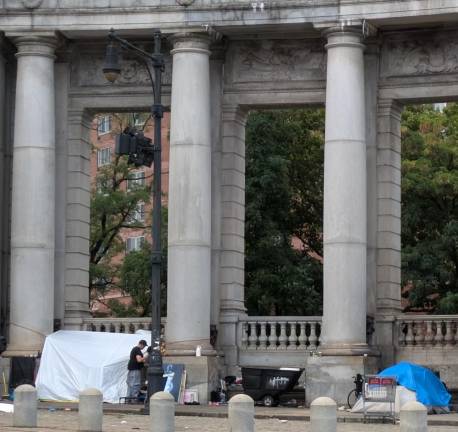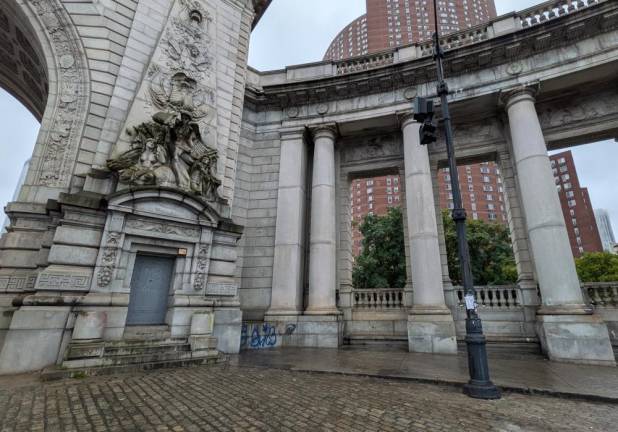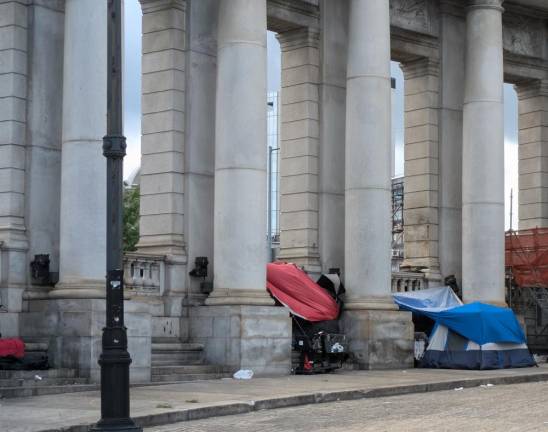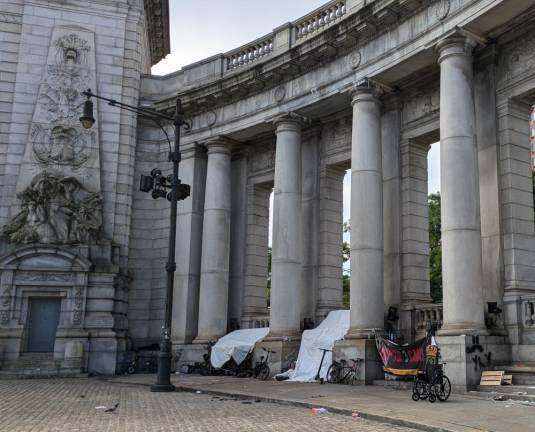Manhattan Bridge Plaza Homeless Do as They Please — Despite Repeated Efforts to Remove Them
The homeless encampment at the foot of the Manhattan Bridge —a longstanding menace to Chinatown locals—was surprisingly cleared out before the city-wide Night Out Against Crime. Within days, however, the shantytown was back.
This is a tale of two tent cities—one on either side of the Manhattan Bridge Plaza.
Or you might call it a shantytown—this last term recalling the popular 1932 Ted Lewis song “In a Shanty in Old Shantytown,” a satire of Depression-era wealth disparity.
What’s going on here at the gateway to Brooklyn, amid the elegant classical columns designed by Carrère and Hastings and opened in 1909?
Constructed of tarps, boxes, crates and other urban detritus and set in a sun-drenched classical setting with ample free parking for e-bikes and scooters and to die for views of Canal Street and Bowery, these makeshift rent-free compounds come—and they go— and then they come right back again after the city clears them out.
In November 2021, Conor Skelding of the New York Post reported the story, “Homeless pitch camp under Manhattan Bridge colonnade,” including comment from bridge denizens, local Chinatown residents and merchants whom they often menace, and even other homeless persons who fear the bridge as a junkie drug den.
The latest turn of this perpetual battled between the unhoused and the government which seeks both to house them and return an artistically and historically notable public space to healthful public use occurred over two weeks in late July and early August.
Visiting the bridge plaza on July 31, Straus News witnessed a scene not unlike that described by Skelding nearly three years earlier. How long the tent city had been growing is unclear because, though we pass the site often, from a distance it’s possible to mistake the tarpaulins for some kind of construction project.
Upon closer inspection, however, the trash, the e-bikes and scooters, shopping carts, the passed-out bodies all show that it’s not.
But who in the summer 2024 notices such things?
The possible answers are many. The tens of thousands of people see it every day driving over the bridge to Brooklyn. Thousands more, traveling on foot, see it as they walk up or down the Bowery. Police from the nearby 5th Precinct see it every day, as do the traffic cops stationed at the foot of the bridge. One can even see the Plaza from the nearby Sarah D. Roosevelt Park, another local spot where drug users and unstable homeless people are common.
The Department of Transportation, which operates the bridge, must know about it though that agency did not reply to repeated Straus News requests for comment.
While the details are unclear, sometime between July 31 and August 7, the tent city was—shockingly!—cleared out.
One suspects it was related to the National Night Out Against Crime of Tuesday August 6, as the removal of the homeless camp before then would mean there was one less local issue that 5th Precinct cops had to address when talking to the community.
Indeed, a query to NYPD press office after Straus News saw the encampment had been removed, brought the following response: “The 5th Precinct is aware of the condition at the location.”
Noting that clearing the camp was a joint operation the Department of Homeless Services, DOT, the Sanitation Department and NYPD, the spokesperson continued, “These agencies have visited the location daily since this past weekend in an effort to address the encampment and offer services to those that may need them.”
This was great news for the community, it seemed, and hopefully an opportunity for the “unhoused” to find better, cleaner accommodations also.
By Sunday August 11, however, this was clearly not the case.
Tent city—or call it a shantytown, was back, and the Manhattan Bridge Plaza strewn with festooned with garbage; passed out junkies and other people; an empty wheelchair; e-bikes; scooters, shopping carts and other flotsam.
Asked about the conditions on the bridge, a 5th Precinct officer admitted every time they clear the people out, many are back the very next day.



